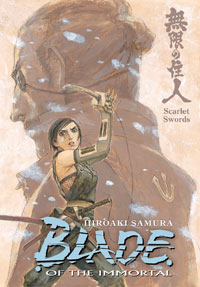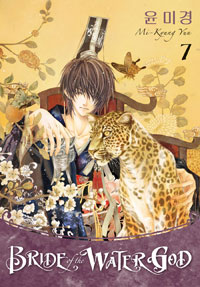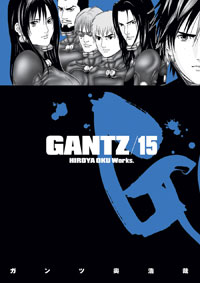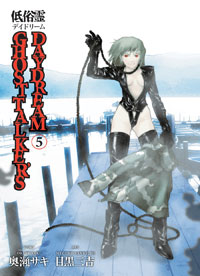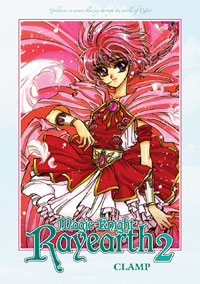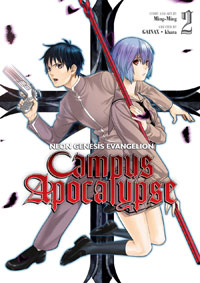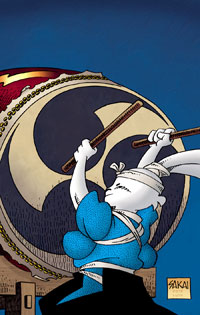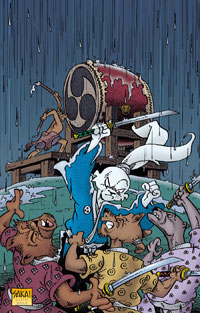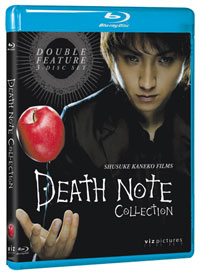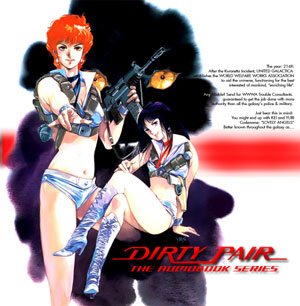 Logo handmade by Bannister
Column by Scott Green
Logo handmade by Bannister
Column by Scott Green
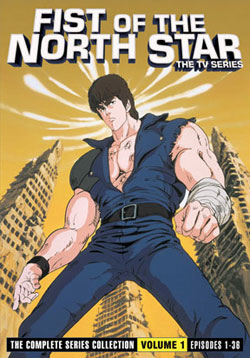
Anime Spotlight: Fist of the North Star The TV Series Vol 1 Newly Released by Discotek Media
I didn't go into this Fist of the North Star release with a nostalgia-based alliance to the 1984 anime series. I'd certainly heard of it during the formative days of my anime watching. The movie and a bit of the TV series were around... their reputation was terrible. It was simply the series in which a guy walked around a post-apocalyptic waste punching people until their bodies exploded, reputed to be so devoid of anything thoughtful as to be beneath any justification for watching. I only caught a little of the anime, and didn't have much of an opinion one way or the other. This was years before the manga boom, but my local library had the first two volumes of Viz's release of the series, and I did come away from reading them impressed by how quickly its hero stomped through adversaries. Watching the Fist of the North Star set, the shonen fight addiction bug bit me, hard. On the notion of "guilty pleasures" Chuck Klosterman wrote In and of itself, the phrase "guilty pleasure" seems like a reasonable way to describe certain activities. For example, it is pleasurable to snort cocaine in public restrooms, and it always makes you feel guilty; as such, lavatory cocaine fits perfectly into this category. Drinking more than five glasses of gin before (or during) work generally qualifies as a guilty pleasure. So does having sex with people you barely know, having sex with people you actively hate, and/or having sex with people you barely know but whom your girlfriend used to live with during college (and will now consequently hate). These are all guilty pleasures in a technical sense. However, almost no one who uses the term "guilty pleasure" is referring to activities like these. People who use this term are usually talking about why they like Joan of Arcadia, or the music of Nelly, or Patrick Swayze's Road House. This troubles me for two reasons: Labeling things like Patrick Swayze movies a guilty pleasure implies that a) people should feel bad for liking things they sincerely enjoy, and b) if these same people were not somehow coerced into watching Road House every time it's on TBS, they'd probably be reading A Portrait of the Artist as a Young Man. Inside, and certainly outside, the domain of watching anime, I can think of plenty of more personally enriching time sinks than watching Fist of the North Star's martial artist hero paralyze a diminutive man who had been attacking him with monkey-fu, then proceed to parade around with the frozen little guy as if he were excrement on a stick. Still, I don't regret spending 800 minutes of my attention on the series. Running in Weekly Shonen Jump from 1983 to 1988, Buronson (the Charles Bronson inspired pen-name of Yoshiyuki Okamura) and Tetsuo Hara stitched together bits of The Road Warrior and Bruce Lee to create one of the most prominent landmarks in boys' manga. When the world was turned to cinders by the nuclear holocaust of 199X, the baddest man left standing was Kenshiro, the sole master of Hokuto Shinken, Divine Fist of the North Star. The titular assassination art used the 708 Keiraku Hiko vital points. Applied pressure via a strike or even a touch causes all manner of effects, from healing; such as curing blindness or psychological trauma to destroying, the body might rip apart of collapse inward, but the favorite effect is to bulge, then graphically explode. In the lawless age following the collapse of civilization, Kenshiro's former friend, Shin decided that in the new world order, the strong should be permitted to take what they desire. What Shin desired was Kenshiro's lover Yuria, and what permitted him to take her (beyond sexism), was that Shin was the master of Hokuto Shinken's complementary martial art, Nanto Seiken, Sacred Fist of the Southern Cross. While Hokuto Shinken attacked internal points of the human body, Nanto Seiken attacked externally, puncturing or cutting with hands or fingers. With Ken's head in the wrong space, Shin bested Kenshiro, using Nanto Seiken to drive his fingers into Kenshiro's chest to scar him in the form of the Big Dipper. Shin then proceeded to start building a kingdom for himself and Yuria around his city of Southern Cross. Ken crawls out of the desert and begins marching towards Southern Cross. Along the way, he meets and ends the lives of hosts of humongou ly, muscled freaks, praying on the various communities try to scrape an existence from the harsh landscape. Shonen series, such as titans of the media Naruto, Bleach, One Piece and so on have a human dimension in which the reader can identify with the hero's problems, and they have a sometimes tiresome iterative process in which the hero trains for the next phase of challenges. That's not Fist of the North Star. Koji Aihara and Kentaro Takekuma's Even a Monkey Can Draw Manga makes the point that ninja manga were once ubiquitous. Then, in the 80's, ninja manga was split by popular 70's sensations Uri Geller and Bruce Lee into the realms of the mental and physical with psychic manga and kung fu manga respectively. There's a reason why Kenshiro is a master on page 1 of Fist of the North Star while Naruto aspires to be one. The genre didn't start with Fist of the North Star, pass through Dragon Ball and become Naruto. Instead, Fist of the North Star is from a different branch of the convoluted history. It was part of the 80's Kung Fu manga. As such, what Fist of the North Star was so popular that did with its progression did inform the younger, developing hero's of the boy's/shonen stories, but Fist of the North Star wasn't exactly proto-Dragon Ball/Naruto/One Piece. From a modern viewer's perspective, a chief merit of Fist of the North Star is its lack of the extraneous. It would be insane to call the anime efficient. This set features a notorious block of padding episodes leading up to Kenshiro's duel with Shin, featuring a host of silly fights with Kenshiro versus a vampire who splits people with a bell, a tanks, and a giant Indian fighter named Devil Reverse or Devil Reborn, not to mention men who shoot themselves out of cannons. Fist of the North Star has an early, signature fight between Kenshiro and the gigantically rotund Heart. In theory, Hearts' excess flesh is supposed to stop Hokuto Shinken. It doesn't work out too well for the fat man. Isn't the significance of that undercut if Kenshiro later fights a tank or an artillery installation? Still, to a remarkable degree, Fist of the North Star lacks hesitation. Especially once Kenshiro gets to Shin, Fist of the North Star turns on the fury. Kenshiro is a warrior who will kill his best friend turned enemy; kill a brother who once elicited some compassion despite being jackass; kill another brother who was once a saint, but subsequently went bad, with only a moment of angry regret and manly tear before cracking his knuckles to get to ending matters. Most of my Fist of the North Star viewing has taken place in recent years, and I'd point to my reaction as evidence that the appeal of Fist of the North Star is nothing psychological. It doesn't need to work as a power fantasy or a display of cathartic violence. What I loved about it is that its simply a manga/anime incarnation of a mindless martial arts movie. It's totally unselfconscious. The best example of this is the introduction of Kenshiro's uneasy ally/Nanto Suichoken master Rei. Here's a brutally efficient, top tier warrior, whose martial art slices through foes with laser-like finger tips. He shows up luring a crew of Fist's Mad Max toughs by donning a purple shawl and fooling them into thinking he's a woman. The first set of foes that he and Kenshiro take down are the Fang Clan, a band of savages whose sense of fraternity goes way overboard... to the extent that they attack settlements to steal teddy bears for each other. Tongue is position slightly towards cheek in those instances, and the series does have a sense of humor, displayed in scenes such as Kenshiro's fight with a wanna-be Hokuto Shinken practioner, but for the most part, it's simply a heedless dive into a pool of memorable violence. Fist of the North Star is not good entertainment, in the sense that it's indefensible as a time sink. It's numbing, and I'm sure that if you hooked up a scanner, you'd see that watching stretches of it does bad things to the human brain. It IS good entertainment it the sense that it's... well... entertaining. Sure, it looks its age. It's predictable. It strictly hosts static, one dimensional characters. Yet, like eating a bag of potato chips, when I finished this 36 episode set, I was disappointed that there wasn't more. Watching Kenshiro rage, screech and piston punch is simply a spectacle that doesn't get old.
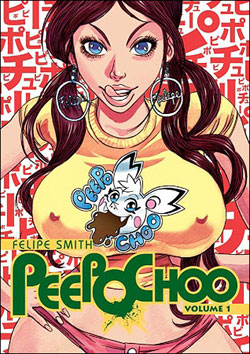
Manga Spotlight: Peepo Choo By Felipe Smith Released by Vertical
Felipe Smith's incendiary MBQ got a bit lost in the wild expansion and contraction of manga in North America. I felt that the violent, satirical rapture announced Smith as the kind of artist whose bandwagon you want to be on early. Unfortunately, my hopes/predictions didn't really pan out, and MBQ became a work that some had high regard for, but which was never really been widely read. Instead, Smith went on to what some would call "live the dream." He moved to Tokyo where he created a manga for publishing powerhouse Kodansha's Morning Two anthology - an eclectic collection of unusual works, including Natsume Ono's (Not Simple, Ristorante Paradiso, House of Five Leaves) American police series Copper , Hikaru Nakamura's comedy about Jesus and Buddha as roommates - Saint Young Men and Ching Nakamura's Gunjou. Peepo Choo is the kind of work bound to evoke comparisons. By no means is it derivative. It's ferociously its own beast. However, thinking about it gets blocked out in terms of other narratives and modes of storytelling. Peepo Choo's banner characteristic is its maniacal culture clash comedy. Beyond Smith's unmistakable flare, as it series was running in Japan, it garnered talk among manga followers for how it handled humor based on assumptions fostered by reductive cultural/linguistic understanding. Specifically, it granted an American geek his wish of travelling to Japan, then it bathed in the disastrous misstates spewed out. Erica Friedman has explained how, in its original language, the geek "renders Japanese into something utterly alien that only special people can understand and is, without fail, a phrase that enrages any American fan who has through sheer effort learned any Japanese. Japanese is not, obviously, a random, bizarre, incomprehensible language". There's a supposedly true story that's been adapted as Densha Otoko. A geek prevents a young woman from being harassed on a train. He then goes to popular message board system 2ch for advice on how to pursue a relationship. And, with the internet's help, the couple finds happiness. Maybe it's really true, but in its popularity and its many TV/film/manga interpretations, that story has been thrust into the realm of fairy tale. It's the shared hope of geeks and those concerned about geeks, that a wall off introvert can integrate into normal society with the right nudge. Peepo Choo is another fairy tale concerning geek hopes. Rather than the idea that with the right happenstance, a geek can be made happy, it's that in the right context, a geek can find kindred spirits and validation. However, unlike Densha Otoko, it's not of the wave a magic wand, set things in order sort, but of the darker, classic variety... featuring obscures rules, fantastic lands, and a somewhat earnest, somewhat foolish hero. And, it's quite dangerous, full of violence of the more "oh no!" rather than "f' yeah!" variety. That explicit danger draws in another point of comparison. The tapestry of colorful people in and just outside its violent circumstances calls to mind a sort of a geek variant Guy Ritchie movie. North America has gotten a sample of the kind of gruesome, grinder of violence that seinen manga can offer... Berserk, Gantz, Blade of the Immortal, Basilisk, Ichi the Killer in the form of its live action adaptation. There are a lot of parties criss crossing Peepo Choo. A few of them are willing in eager to engage in a bit of seinen brand ultraviolence: sticking fingers in eye sockets, disemboweling and so on. Milton is from a crowded household in the South Side of Chicago. He leaves his family looking like a semi-respectable student, then, once outside spotting range, he takes off his glasses, puts a bandage on his face and a bandanna on his skull, skews his hat, throws on a White Sox jacket and adopts a hard expression. A train ride away, he ducks into a donut shop, leaps into the bathroom, and changes that attire for baggy white shorts, a "P" emblazoned jersey and a floppy eared cap. He leaps up and down, puts his ankle behind his neck and declares "Howdy Sir Milk Dog! Peepo Choo!" See... Milton is a hard core, self defined otaku. Rather than attend school, he's been working at a comic shop. His manager, or rather the guy whose work he does, Jody, hates geeks of all stripes. Jody's thing is sex. Day and night, barking insults at the nerd or alone in his room, he's attached to some form of pornography. And that smut become the basis for the wild stories of imagined experiences with which he enthralls the worshiping customers. And, Enyo's Game, Comics and Collectable's owner is ex-con, Gill, a hulk with a saw blade mustache who combs out his Mohawk and looks dauntingly semi-respectably when he's not out on non-enthusiast consumer business. Business takes Gill to Japan. For Milton, it represents an opportunity to dive into a culture he knows of and worships via the comedy adventures of mascot character Peepo Choo. For Jody, it represents the prospect of getting strange in a land that he holds out hopes works like the plots of his porno fantasy. The course of this American trio is evidently heading in the direction of a trio of Japanese counterparts. There is Rockstar, formerly Takeshi, Morimoto, the adopted protégé of a yakuza big brother who seems to have cooked his head by massive consumption of American gangster stories; Reiko Kawamori, a teen pin-up queen who seems to be add odds with everyone despite being an object of adoration, and "Butt-Ugly" Miki Tanaka, a bullied girl who finds some escape in grotesque/cute loli-goth curios. Peepo Choo is millimeters away from being luminously fun. There's a glint in its eyes as it launches one charged, cartooned image after another. And, Smith serves that up with a remarkable command of the medium. You can argue about distinctions between original English language manga versus Japanese manga, and whether those arguments are useful or appropriate. In this case, the conversation truly doesn't seem very relevant. Smith's work doesn't need much comparison to Japanese or American comic book traditions because he has an understanding of how comics work that allows him to tell stories in his own way. Some artists have a real grasp of how a reader’s attention moves from panel to panel page to page. For example, among her gifts, Rumiko Takahashi is a master of this, selling gags in the paced transition from one panel of Ranma to another or shock in the flip of a page in her horror manga series Mermaid Forrest. Comics/manga can rest on isolated ideas. A gag is presented on one panel of a comedy. An attack is presented on one panel of an action story. Plenty of respected creators come up with concepts that connect to their audience well enough that these snaps shots are more than sufficient. The boldness of Smith's characters and situations could have stood alone. But, he is also able to embellish it with a command of how reading the manga flows. Peepo Choo's gags are given more impact by the discernable beat in the delivery of lines and interaction between characters. Big, brash, and boisterous, full of potential for vicarious thrills, Peepo Choo could have been tremendously fun. It's not, and not just because it's exceptionally nasty business of grotesque propositions. Add Big Fan to the list of stories that Peepo Choo calls to mind. With the internet; with the glut of media out there; There's the notion that if someone surrounds themselves with selected ideas and trapping they can be what they want to be. The heated argument from North American enthusiasts about whether the extensive baggage attached to the term "otaku" can be pruned off and a person can/should identify themselves as one is a demonstration of this idea. For many of Peepo Choo's characters, this adoption of an identity isn't just a matter of how they spend their private time, it's how they project themselves and hope to interact with the world. And here, all that runs into a brick wall. The characters' escapism and their coping mechanism come face to face with authentic reality. In the way that its gory violence is exceedingly confrontational, the shattering of what these wannabes erect around themselves is equally a broadside on the reader. The prospect of the violent characters meeting up is cringe inducing, but the prospect of Milton and Jody walking into a Japanese city also looms like psychological torture porn. This is more an assault than a subtle discourse. Shoving out foul caricatures, Peepo Choo crowds the reader with a host of characters, all of whom are in some respect, disquieting. There's no apparent control group; no counter example that the reader can acknowledge has their business together. So, it all compounds itself into one brutally ugly picture. No one comes out looking well, but geeks come in for an especially brutal brow beating in this savage aversion therapy, with their fantasies warped into hairy, misproportioned sexualized images. Jody might later have his knees cut out from under him, but that doesn't make his rant about the unified wants of warring anime and comic geek factions any more caustic. The titular Pokemon-ish mascot critter of the title might not seem like the kind of anime to be the object of a teen geek's obsession , but its absurd juvenileness is very much at home with the series' argument. Exactly how dire Peepo Choo's world view really is remains to be seen. At the end of volume one, it looks to be on a rather nasty precipice. Specifically, Milton is seldom more sympathetic than when he's pouring over Peepo Choo anime, trying to teach himself the Japanese language... and on some level, even he knows the results of this method of learning are bound to turn out disastrously. More generally, the landscape it's sketching is offering few non-pathological avenues for personal satisfaction. On the other hand, as dangerous as this fairytale's dark forest might be, maybe Milton can navigate it towards reward. A volume in, I respect Peepo Choo more than I enjoy it. The craft is exciting, but it's intentionally abrasive. I like abrasive and I like provocative, but I also feel that the qualities put an onus on a work, as they're liable to take out its bottom if not carefully applied. Caustically amusing Milton is a difficult center to hold the story. While there is room to shift here, the inclination is to withhold investment in the character until he shows some sign of being more than the butt of the joke. At the same time, the manga doesn't foster reader sadism. It is difficult to like disliking this cast. Don't let the unpleasantness hold you back. Smith is skillfully, provocatively exploring some relevant ideas. Just, as amazing as it is to watch him do it, if even neither violence nor the message offends you, Peepo Choo is still decidedly prickly.
Upcoming in North America
Dark HorseBLADE OF THE IMMORTAL VOLUME 23: SCARLET SWORDS Hiroaki Samura (W/A) On sale Jan 26 b&w, 224 pages $19.99 TPB, 5 3/4" x 8 1/4" BRIDE OF THE WATER GOD VOLUME 7 Mi-Kyung Yun (W/A) On sale Jan 19 b&w, 192 pages $9.99 TPB, 5 7/8" X 8 1/4" GANTZ VOLUME 15 Hiroya Oku (W/A) On sale Jan 5 b&w, 224 pages $12.99 TPB, 5 1/8” x 7 1/16” GHOST TALKER’S DAYDREAM VOLUME 5 Saki Okuse (W) and Sankichi Meguro (A) On sale Jan 12 B&w, 240 pages $10.99 TPB, 5" x 7" MAGIC KNIGHT RAYEARTH VOLUME 2 CLAMP (W/A) On sale Jan 19 b&w, 640 pages $19.99 TPB, 5 1/8" x 7 1/4" NEON GENESIS EVANGELION: CAMPUS APOCALYPSE VOLUME 2 Ming Ming (W/A) On sale Dec 29 b&w, 160 pages $10.99 TPB, 5 1/8" x 7 1/4" USAGI YOJIMBO #132 and #133: TAIKO Parts 1 and 2 Stan Sakai (W/A) On sale Oct 27 b&w, 24 pages $3.50 Ongoing On sale Nov 24 b&w, 24 pages $3.50 Ongoing Kodansha International In an interview with Publishers Weekly, Sean Michael Wilson (editor of Top Shelf's Ax anthology release), reveiled that Kodanasha International (not to be confused with Kodansha Comics, releasing Akira and Ghost in the Shell) will be releasing Hagakure, a manga adaptation of In the Shadow of Leaves, one of the fundamental books of Japanese culture and philosophy and an English language adaptation of author Shoko Tendo’s autobiography Yakuza Moon Sentai Filmworks Sentai Filmworks announced its acquisition of 45 episode, 1993 horror comedy series GHOST SWEEPER MIKAMI. If you’ve got a ghost in your neighborhood, and your neighborhood is in Japan, you’d better put in a call to Ghost Sweeper Mikami, where disposing of things that most people don’t even believe exist is their stock in trade. Demon in the woodwork, hopping vampire in the pantry? Don’t worry! No case is too big or too small, since the lovely but avaricious Reiko Mikami will take any case that pays and her loyal but perverted sidekick Tadao will do anything that might let him sneak a peek at Reiko’s magnificent physique. How unfortunate for him that Reiko basically sees him as cannon-fodder, something that’s quite useful when your day to day business involves exorcising oni, yurei, yokai and anything else you might find in The Illustrated Bag of One Hundred Random Ghosts. It’s supernatural sleuthing where the bad guys aren’t wearing masks and the unexplained is both expected and usually lethal in GHOST SWEEPER MIKAMI! VIZ Media VIZ Pictures will debut the Blu-ray Death Note Collection on August 24th, 2010. The 3-disc set includes 2 feature films – Death Note and Death Note II: the Last name – as well as a bonus disc containing more than two hours of all new behind-the-scenes footage. Both films feature Japanese audio with English subtitles as well as an English dubbed dialogue track. MSRP for the Death Note Collection is $39.98 U.S. / $57.99 CAN. To celebrate the new release, VIZ Pictures will hold a special screening of both films at VIZ Cinema, located inside NEW PEOPLE in San Francisco’s Japantown (1746 Post St., San Francisco, CA 94115) on Saturday, September 4th. Death Note plays at 12:00 noon and Death Note II screens at 2:30pm. Special combo tickets are available for $35.00 and include passes for the screenings, the Blu-ray release and a poster. Regular combo tickets are $15.00 for tickets for both shows (no Blu-ray or poster), while general admission for one screening is $10.00. Tickets and information are available at www.vizcinema.com.
Upcoming in Japan
Promos Mazinkaizer SKL Yozakura Quartet: Hoshi no Umi IS ~Infinite Stratos~ To Love-ru ~Trouble~'s new series Gegege no Nyobo - the movie version of the Nunoe Mura, wife of GeGeGe no Kitaro creator Mizuki Shigeru, autobiography Supernatural - the Madhouse adaptation of the American TV show Anime Production I.G and Xebec parent company IG Port revealed in their fiscal 2010 reports that two theatrical films and a sequel to a popular franchise are in the works for the 2013 fiscal year. IG Port's 2013 fiscal year runs from June 1, 2012 to May 31, 2013.* A tv anime version of "high-tension, chaotic comedy" light novels Haiyore! Nyaruko-san, concerning a moe version of Cthuhlu mythos evil Nyarlathotep has been confirmed. A flash anime adaptation has already been produced.* Yutaka Yamamoto (Haruhi Suzumiya) is confirmed to be directing Hiroki Azuma and Mari Okada developed Fractile for the Noitamina programming block According to Anime News Network, the story is set on an island at the far reaches of a continent where the "Fractale System" is on the brink of collapse. A boy named Kurain embarks on a journey to search for Furyune — a girl who disappeared, leaving behind only a pendant. Kurain will eventually learn the secrets of the "System."* A new Hidamari Sketch × ??? Tokubetsu-hen art school student anime special is slated for direct to video release in October* A second anime adaptation of gender swap action comedy light novels Kämpfer has been confirmed* The .hack multi-media fantasy game franchise will be getting a new anime with .hack//Quantum* Sunrise anime studio is producing Koisento, a "super science-fiction romantic comedy" original video anime with the staff behind the Freedom anime project. The anime, set in 2710, is set on a field trip to a historical cultural preserve.* Rio -Rainbow Gate!, featuring the star of the Super Black Jack will hit Japanese TV in 2011* a second season of Disney's Fireball is on tap for 2011* The announced, second Shinshaku Sengoku Eiyuu Densetsu Sanada Jyuu Yuushi The Animation apparently isn't really happening Manga kakifly's girl rock band manga K-ON! will be ending in the September issue of Manga Time Kirara* Bessatsu Shonen Magazine is launching Yui's Negima spin-off Negiho Bun Ito, features the parent manga's characters as children.* The next issue of Monthly Shonen Gangan will feature a spin-off of recently concluded Fullmetal Alchemist Live Action There are rumors of a live action Lupin III in the works* Kenichi Matsuyama (Death Note) will start as the principal in Sabu's adaptation of Yumi Unita's Bunny Drop manga, about a 30 year old bachelor who takes in the 6 year old illegitimate daughter of his recently deceased grandfather.* Long running police manga Kochira Katsushika-ku Kamearikouen-mae Hashutsujo, better known as Kochikame, will be adapted into a live action movie* Manga Ushijima the Loan Shark will be adapted into a live action TV series* Kazune Kawahara's manga High School Debut is getting a live action movie adaptation* Yuya Yagira has been added to the cast of the live action TV drama adaptation of thriller/fight manga Tokyo23: Survival City misc The theatrical troupe Africa-za will be performing a stage play adaptation of mecha animeSoukyuu no Fafner: Dead Aggressor ~ Fact and Recollection~ Voice actresses Miyu Matsuki (Shouko) and Nanaho Katsuragi (Youko) will reprise their respective roles in the play. Africa-za's Hiroshi Nakayama is co-writing and directing this adaptation of Xebec and Tow Ubukata's story.
Digital Distrobution News
Comics Alliance on Upheaval in the Manga Industry: Piracy, Scanlations, and the Future of Digital Manga* Deb Aoki's report on the ComicCon digital piracy panel* Kurt Hassler on Yen Plus online* 101 episodes of Slam Dunk are now streaming on Anime News Network* FUNimation has begun streaming Okamisan and Blessing of the Campanella They're also streaming the first episode of Eden of the East* DramaFever.com announced that it has obtained North American online distribution rights from FUNimation Entertainment for the hit live-action CG-animated situation comedy adaptation of the award-winning manga series “Moyashimon,” (2010), written by Masayuki Ishikawa and directed by Akira Iwamoto. New episodes will be added weekly around the same time every Thursday. Adapted from Masayuki Ishikawa's comedic popular manga, Moyashimon, the situation comedy follows Tadayasu Sawaki (played by Nakamura Yuichi), a 20-something student at a Tokyo university who has an unusual superpower, which makes him able to see and talk to comical, quick-witted microbes who mock him and give running commentary as he adjusts to his university life. Monster Hunter - MonHun Nikki Pokapoka Airu Mura anime episode 1 online
Event News
NEW PEOPLE will expand its upcoming 2010 J-Pop Summit Festival, happening on Saturday, September 18th in San Francisco’s Japantown, with a special series of events taking place at the venue each night during the week leading up to the Festival. Tickets are now available on www.J-Pop.com. Beginning on Monday, September 13th and continuing every evening through Friday, September 17th, different aspects of Japanese and Asian film, anime, fashion design, music and other forms of pop culture will be celebrated in a series of unique screenings, interactive discussions, multimedia presentations and live performances. Special gift bags containing a variety of fun premiums will be given to all ticket holders each night. TOKYOSCOPE TALK, Vol. 6: Bad Girls & Wild Women Monday, September 13th at 6:00pm Join hosts Patrick Macias (Editor, Otaku USA), and Tomohiro Machiyama (founding editor, Movie Treasures magazine) for a unique look at sexy Stray Cats, Female Prisoners, Delinquent Bosses and other captivating and sexy bad girl roles from Japanese cinema. The evening will be complemented by a theatrical screening of the lurid prison film Female Prisoner #701: Scorpion. Adults only due to mature subject matter; 18+ General admission tickets for the discussion and film screening are $20.00. ANIME NIGHT with Animation On Display & Crunchyroll, Tuesday, September 14th at 7:00pm Animation On Display, San Francisco’s very own anime convention, joins forces with leading online content provider Crunchyroll for a theatrical presentation of Makoto Shinkai's "5 Centimeters Per Second”. The evening will also include a special VIP reception, open to the public, as well as a Q&A session about the film. Come meet other anime fans and join the fun with a special evening celebrating anime! General admission tickets for the film screening are $10.00. 6%DOKIDOKI HARAJUKU FASHION NIGHT Featuring Designer Sebastian Masuda, Wednesday, September 15th at 6:00pm 6%DOKIDOKI shop girls Yuka and Vani will offer a mini-fashion show of some of the company’s newest ensembles and audience members are invited to try out for a chance to model new designs to be showcased at the J-Pop Summit Festival on Saturday, September 18th. General admission tickets for the lecture and fashion show are $20.00. Noise Pop Meets J-Pop: Film Screenings of 77 Boadrum, preceded by Cornelius - Synchronized & Sensurround Thursday, September 16th at 5:30pm Happy Hour; Screening at 7:00pm Join Noise Pop, organizers of the leading independent music festival in the Bay Area, for a special theatrical presentation of 77 Boadrum. On July 7, 2007, Japanese free-rock group the Boredoms staged a live performance featuring 77 drummers at the Empire-Fulton Ferry State Park in Brooklyn, NY. 77 Boadrum is the official live documentary of this incredible event – complete with behind the scenes rehearsal footage, interviews, and of course, the actual performance. With intense, chaotic energy that melds into a No-Wave rock infused format, the Boredoms have garnered international attention for the member’s incredible rhythmic power, clever melodic punches, and sheer chaotic intensity. Since exploding onto the scene in 1997, Japanese musician Cornelius has dazed and amused fans worldwide with his freeform pop aesthetic and playful sense of humor. His short music videos are edgy and exceptional, the live ones being seen for the first time in the U.S. There will be a complementary Happy Hour before the screening. General admission tickets for the film screening are $10.00. MYX VIP Party Friday, September 17th at 6:00pm Free admission. RSVP at www.j-pop.com* Creator Tow Ubukata will personally present the world premiere of the first Mardock Scramble anime film at New York Comic Con on October 8. The North American book distributor Simon & Schuster is already listing a Mardock Scramble book by Ubukata for a January 2011 release by Viz Media. Simon & Schuster describes the plot of the book as the following: Why me? It was to be the last thought a young prostitute, Balot, would ever have…as a human anyway. Taken in by a devious gambler named Shell, she became a slave to his cruel desires and would have been killed by his hand if not for a private investigator and his self-aware Universal Tool, Oefcoque. Now a cyborg, Balot has not only physical powers, but the ability to disrupt social environments. She chases after Shell, his partner-in-crime Boiled, and faces down a variety of insane villains in this pulse-pounding cyberpunk noir adventure.* Baltimore's Otakon 2011 has been scheduled for July 29-31
Cool Figures News
Volks will be release a figure of Slayers' Lina Inverse in October more shots of the Lupin III Revoltech Gundam Super Expo 2010 Matsuri Season: Anime Heroes and Heroines in Festival-Themed Diorama From NiubNiubsUniverse.Com Super7 will be at Orlando's Star Wars Celebration V with a limited edition Stormtrooper Super Shogun Star Wars fans who purchase the Stormtrooper Super Shogun during Celebration V will receive a free vintage Kenner action figure sealed on its original blister card. Characters selected at random, and the offer is valid only while supply of figures lasts.
The Business
ICv2 Interviews Viz’s Alvin Lu On the Market and the Company, Post-Downsizing* Over the last fiscal quarter, the Starz Media, that includes the studios Film Roman, Anchor Bay and Manga Entertainment, suffered a US$42m impairment charge due to film release timing issues and lower TV revenues.
Worth Checking Out...
Mike Dent will be launching an audio book adaptation of The Great Adventure of the Dirty Pair Anime 3000 with a dramatization of the misadventures of anime/light novel's infamous sci-fi heroines Kei and Yuri In the distant future, mankind has spread themselves out across the stars. With this new frontier comes new troubles and crises. Sometimes the police can't cut it, and there are moments when even the United Galactica space fleet can't scratch the surface! That's where the WWWA (or 3WA) come in: An organization devoted to the welfare of the galaxy by solving any problem before it snowballs into a major threat. Among the many "Trouble Consultants", there exists one team that strikes fear into the hearts of civilian and criminal alike--the Dirty Pair. Kei and Yuri are infamous throughout the stars for their tendency to always get the job done (while leaving a trail of collateral damage in their wake). Their official codename is "The Lovely Angels", but you'd be hard-pressed to find somebody who doesn't call them The Dirty Pair....and hasn't gotten slugged in the face for it. Insight newly translated Mamoru Oshii: The Venezia Tapes Sci-Fi Japan reviews Space Battleship Yamato: Resurrection Iwa ni Hana on Arakawa Under the Bridge Yakuza review the game Yakuza English dubbing director Gary Rydstrom discusses 'Tales From Earthsea' Ani no Miyako on BLACK?ROCK SHOOTER Midnight Eye has been updated with new reviews and features reviews of Welcome to the Space Show on Otaku USA and Mike Toole's revived Anime Jump Helen McCarthy on Daily Manga: The Long Runners The History of Anime: Origins – 1962 Jonathan Clements on the popularity of magic girls in English speaking territories Gamasutra on Sengoku Basara's Stylized Take On Japanese History a look at mahjong anime/manga Media Our Alliance — A Lasting Partnership - manga celebrating American military involvment in Japan Godzilla vs Them Crooked Vultures a little of Tezuka's Crime and Punishment survey of Akihiko Yamashita animation Transformers animated Shorts: Sprowl animation by Gainax' Akira Amemiya Sym-Bionic Titan preview clip Selected panels from Yoshihiro Tatsumi's Black Blizzard, presented with minimal commentary Dr. House vs. Black Jack ~ Video Shonen Jump art Steampunk Casshern a MegaMan Manga preview Misc Reports from the Hiroshima Animation Festival Golgo 13’s “Hard Black” Must Be the Most Manliest Coffee Ever CR Godzilla Pachinko Launch Event a Tetsuo Hara illustrated timeline Junko Mizuno on twitter a list of manga creator who will be at Comiket Italian pair selected as world 'cosplay' champion Manga @ Tsutaya "Over 9000"'s Kajetokun Banned from YouTube

